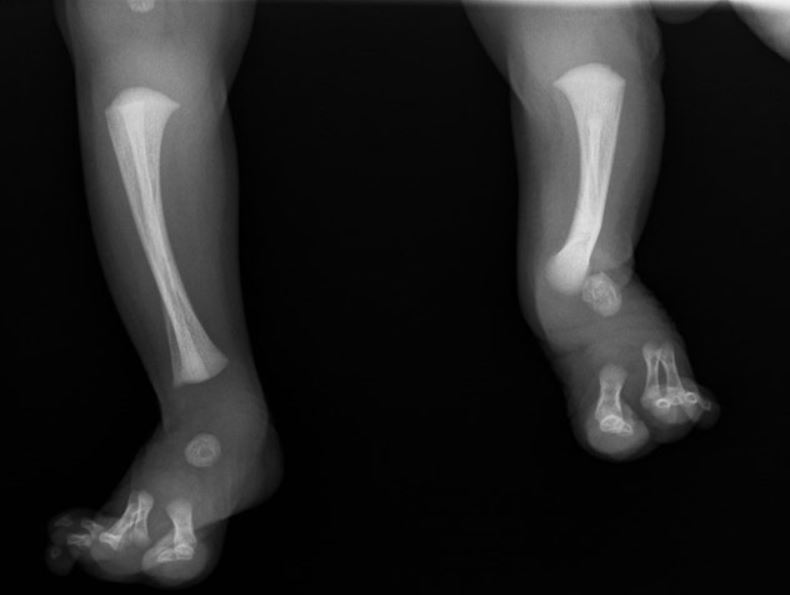As an Amazon Associate I earn from qualifying purchases.

FATCO syndrome is a congenital disease that causes deformity in limbs. It is a rare disorder with estimated cases of 5.7 to 20 cases per one million births. It is first described by Hecht and Scott in 1981 and also called the “Hecht-Scott” syndrome. It is purely a syndrome of unknown genetic basis and inheritance.
The acronyms of the syndrome are descriptive terms and stands for three kinds malformations such as:
- Fibular Hypoplasia/Aplasia.
- Tibial Campomelia.
- Oligosyndactyly.
Symptoms
It is a rare medical condition where bones in extremities do not fully develop. The syndrome variants are:
- Fibular Hypoplasia/Aplasia is a rare congenital lower limb oddity characterized by partial or complete absence of fibula(long, thin lateral bone of the lower leg). This disease spectrum ranges from mild Fibular hypoplasia to Fibular Aplasia.
- Tibial Campomelia is a rare skeletal dysplasia where the affected individuals are born with shortening and bowing of tibia (long bone in the legs) with overlying soft tissue dimpling. It involves anterior bowing of tibia in major cases. The bowing occasionally occurred in the arms which results in permanent curvature of the affected part.
- Oligosyndactyly means the presence of fewer than five toes or fingers in the foot or hand.
All three symptoms may be present unilaterally or bilaterally. However, these symptoms have not been developed in an equal or uniform manner in different patients. Children affected by the disease demonstrated great clinical variability. Children with FATCO syndrome are evident to have normal mental development. They don’t show any kind of facial dysmorphia or other anomalies.
All the cases of the syndrome reported to date have three major common findings so they proposed to name it as fibular aplasia–tibial campomelic–oligosyndactyly or FATCO syndrome which makes it a purely descriptive term.
Etiology
The cause of the syndrome is still unclear. Although there are some cases found to have genetic distribution in a family but it doesn’t account for maximum cases. In the majority of cases, it is found to have no genetic traces. In most cases, it is caused by non-genetic or teratogenic causes such as radiation, maternal infections, climate, drugs, etc.
It has been observed that the disruption of the lower limb developmental field occurs during embryogenesis. This developmental field encompasses the defects seen with Fibular hypoplasia and involves defects of fibula and femur.
Another interesting fact that mutation of WNT7a, a gene, is responsible for the limb malformations. But in this case, no mutation develops in the WNT7a gene raises the eyebrows. It shows a great similarity with Fuhrmann’s syndrome but unlike FATCO syndrome, a mutation in the WNT7a gene is recorded. But again it left us with an ambiguous cause of the disease.
Chromosomal microarray analysis did not show any genetic abnormalities in this case. A genetic basis for this condition remains to be identified. It may be a part of the malformation syndrome.
It can be associated with great morbidity and mortality due to its association with multiple body systems. Hence, an early diagnosis is required.
Diagnosis

Diagnosis of FATCO syndrome can be done as early as the antenatal stage and even one day old. It is important to diagnose as early as possible. Prenatal screening can reveal the syndrome by observing skeletal abnormalities. So, the age of onset can be at the stage of neonates or antenatal. These are the following diagnosis methods:
- Radiographic examination.
- Ultrasonography is another method for diagnosis in the prenatal stage.
- physical examination in the case of neonates.
- computerized tomographic (CT) scan.
Treatment
FATCO syndrome can’t be prevented as the source is still unclear. The anonymity of the disease provides that vulnerability. Hence understanding this disorder at prenatal stages will allow for an earlier diagnosis through the identification of key features. The disease ultimately requires corrective surgery immediately after birth. Prenatal identification of this syndrome allows the opportunity for informed family planning. Hence early intervention is important to avoid further damage through preservation of the foot by surgical or non-surgical treatment.
There are several treatment methods practiced to cure the disease.
- The goal of treatment for fibular hemimelia is to correct the leg length difference and to functionally stabilize knee and ankle joints. Hence equalization of the lengths of the extremities is the most desirable treatment for Fibular hemimelia.
- Treatments for fibular hypoplasia include limb lengthening procedures and use of prosthesis where an artificial device is used to replace the body part that may be missing, malfunctioning, or partially or completely damaged.
- Epiphysiodesis is another excellent treatment method which is an orthopedic surgery procedure aimed at altering or stopping the bone growth naturally occurring through the growth plate. The combination of epiphysiodesis with elongated procedure gives the best result.
- Fabrication of new orthosis is another ideal alternative for a non-surgical procedure. It is an external device applied to a part of the body for support.
- Another surgical method is amputation. It means the removal of the limb to control pain or disease process in the affected limb. Amputation along with early use of prosthesis seems to be effective.
- Nonetheless, a detailed discussion with the pediatric orthopedic surgery as to the surgical timeline allows the mother and family to make informed decisions and plan for the necessary adjustments to their home as well as life. It will help to result in early genetic counseling of the concerned parents.
Conclusion
The cause of FATCO syndrome remains unknown. It is very likely that many patients were misdiagnosed because the clinical symptoms show some degree of heterogeneity, and as a result not reported. Given the less number of reports on this rare disease and the lack of a standardized treatment approach, it is vital that each case of FATCO syndrome is reported. Since many parents are not aware of this rare disease, the spread of word is essential especially to every pregnant couple. It will subsequently permit adequate parental counseling about pregnancy development and preparing them for what is inevitable. It is very important to make them aware of the nature of the disease and what the future looks like for the parent and the child.